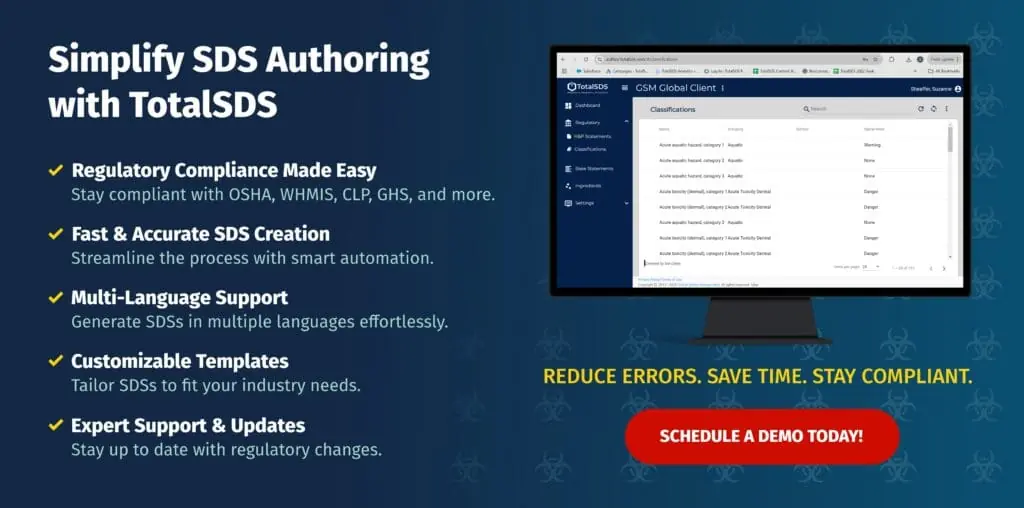CAS numbers are an important part of any Safety Data Sheets (SDS)—but, with over 200 million registered substances, one small mistake when listing CAS numbers can lead to a chain of errors, lost time, and wasted dollars that can eventually be traced back to the source.
TotalSDs offers a comprehensive solution for managing CAS number issues by providing an efficient and accurate database for chemical substance identification. Our SDS Authoring software platform streamlines the process of tracking and resolving CAS number discrepancies, ensuring regulatory compliance and reducing errors in chemical data management.
Discover How to Manage CAS numbers with our SDS Authoring Software
Here’s what you need to know about CAS Numbers and how to get them right the first time when authoring SDSs.
What is a CAS Number?
CAS stands for Chemical Abstract Services, a division of the American Chemical Society committed to creating the world’s most comprehensive and valuable database of chemistry content vital to worldwide innovation.
A CAS number, also known as a CAS RN (CAS Registry Number), is a short string of numbers that refers to a particular chemical substance. It contains a maximum of ten digits grouped into three sections by hyphens.
A CAS number is used to identify chemicals in a unique, unmistakable way. Rather than rely on other chemical naming systems, which have inherent limitations of their own (long words, complex naming rules, etc.), the CAS number offers a short and reproducible identification that can be used for chemical inventory listings and more.
How is a CAS number assigned?
The process involves assigning a unique numerical identifier – the CAS number – to each chemical substance based on its specific chemical structure and properties, facilitating accurate and consistent identification across scientific literature and regulatory documents.
How to Find a CAS Number:
To find a CAS number for a specific chemical substance, you can use the following methods:
- Chemical Databases and Online Resources: Websites like the Chemical Abstracts Service (CAS) database, PubChem, and other chemical information databases allow you to search for substances by name, formula, or structure to locate their CAS numbers.
- Scientific Literature: CAS numbers are often listed in research articles, safety data sheets (SDS), and chemical product labels. Reviewing these sources can provide the CAS number for the substance in question.
- Professional and Regulatory Resources: Regulatory agencies and industry standards, such as those from the Environmental Protection Agency (EPA) or the European Chemicals Agency (ECHA), may list CAS numbers in their chemical inventory databases and guidelines.
- Contacting Manufacturers or Suppliers: Chemical manufacturers and suppliers can provide CAS numbers for their products upon request. They typically include this information in product documentation and safety data sheets.
How TotalSDS Authoring Software Can Help with CAS Numbers:
TotalSDS authoring software simplifies the process of finding and managing CAS numbers by integrating robust features designed for accurate and efficient chemical data handling:
- Integrated Database Access: TotalSDS provides access to extensive chemical profiles within its platform, allowing users to quickly search and retrieve CAS numbers and related information without needing to consult multiple sources.
- Automated Data Management: The software automates the retrieval and management of CAS numbers, reducing manual entry errors and ensuring that the correct CAS numbers are used consistently across safety data sheets and other documentation.
- Regulatory Compliance: TotalSDS helps ensure that CAS numbers and other regulatory data are up-to-date and compliant with current regulations. This feature minimizes the risk of regulatory issues and improves the accuracy of safety documentation.
- Streamlined Authoring Process: By integrating CAS number searches and data management into the authoring process, TotalSDS enhances efficiency, allowing users to focus more on content creation and less on administrative tasks.
By leveraging TotalSDS authoring software, you can streamline the process of finding and managing CAS numbers, ensuring accuracy, compliance, and efficiency in your chemical data documentation.
What is a CAS number used for?
SDS CAS numbers are used to identify chemical substances in many databases, both public and private, as well as other chemical inventory listings.
When authoring SDSs, CAS numbers must be listed in Section 3:
Composition/Information on Ingredients. In this section, ingredients are identified by chemical name, common name and synonyms, their CAS numbers, and other unique identifiers. It provides unmistakable data that players downstream in the supply chain will then use to register the substance and purchase the correct Letter of Access before placing the product on the market.
Why do I need a CAS number to begin authoring a safety data sheet?
An ingredient’s CAS number is a vital piece of information used to clarify which chemicals, including impurities and stabilizing additives, are present in the product.
Something as small as being one digit off when listing the CAS in Section 3 can cause downstream users (DU) of your supply chain to register the incorrect substance, ultimately delaying the timeline to get the product on the market. When the error is traced back to an SDS authoring mistake by you, the supplier, the DU who suffered will likely seek damages from the source.
It may seem like a small detail, but regulatory staff takes this kind of thing seriously, as it can quickly lead to hundreds of thousands of wasted dollars and months. It’s critical to get all of the details right the first time.
What if my supplier shows impurities mixed with a CAS number?
Often supplier SDSs show 90-99% of the CAS number you think you are purchasing, however impurities and the amount of them may vary by supplier. It is important to account for these impurities. If you need help managing multiple suppliers, you can refer back to our previous blog here.
How to Avoid CAS Number Errors
There’s no room for error when it comes to listing CAS numbers on your SDS. SDS automation through our patent-pending SDS authoring software, TotalSDS, will ensure compliance and accurate reporting, keeping the supply chain in motion and protecting you from any damages owed to downstream partners.




